Grapho- Words Meaning Write, Record: “gastrograph” to “gyrograph”,
Part 5 of 11.
Words that include: grapho-, graph-, -graph, -graphy,
-grapher, -graphia
(Greek: to scratch; write, record, draw, describe).

gastrograph, gastrokinesograph:
An instrument for recording graphically the movements of the stomach.
geography, geographic, geographical:
The science that has for its object the description of the earth’s surface, with reference to its form and physical features, its natural and political divisions, the climate, productions, population, etc., of the various countries.
glossography, glossograph, glossographical:
1. The writing of glosses or commentaries; the compiling of glossaries.
2. A written description of the tongue. A description or grouping of languages.
3. An instrument for recording the movements of the tongue when speaking.
glyptography, glyptograph, glyptographic:
1. The art of engraving upon gems.
2. The descriptive science of engraved gems.
graffiti:
An Italian word meaning, “anything written or drawn on rocks or walls so as to be seen by the public”. This is the plural of Italian graffito, “an inscription scratched on rocks or walls or on artifacts made of plaster, stone, or clay”. Many writers agree that graffito came from Greek graphein, “to scratch”.
graph:
1. A kind of symbolic diagram (used in chemistry, mathematics, etc.) in which a system of connexions is expressed by spots or circles, some pairs of which are colligated by one or more lines. Also, occasionally the system expressed by one of these diagrams.
2. In medicine, a line or tracing denoting varying values of commodities, temperatures, urinary output, etc.; more generally, any geometric or pictorial representation of measurements that might otherwise be expressed in tabular form.
3. An apparatus of the nature of the chromograph, hectograph, etc., for taking copies of writing by pressing it on a gelatinous surface.
4. In philology, a visual symbol representing a phoneme or a segment or feature of speech; especially, a letter, or one of its occurrent forms, or a combination of letters.

graphanalysis:
The reading of character or personality from a person’s handwriting.
graphanalyst:
One who specializes in character reading or analysis of peoples’ handwriting.
graphanesthesia:
1. In psychiatry, a disturbance of graphesthesia (a function of the dominant parietal lobe), consisting of the inability to recognize letters that are traced one at a time on the palm of the hand while the subject’s eyes are closed.
2. In medicine, tactual inability to recognize figures or letters written on the skin which may be due to spinal cord or brain disease.
grapheme, graphemic:
Any of a set of written symbols, letters, or combinations of letters that represent the same sound, e.g. “f” in fat, “ph” in photo, and “gh” in tough.
graphemics:
In linguistics, the study of systems of writing and their relationship to the systems of the languages they represent.
graphesthesia:
Tactual ability to recognize writing on the skin.
graphetics:
A term, coined on analogy with phonetics, is the study of the physical properties of the symbols that constitute writing systems.
graphic:
1. Of or pertaining to drawing or painting; as in, graphic arts. The fine arts of drawing, painting, engraving, etching, etc.; also, the techniques of production and design involved in printing and publishing.
2. Pertaining to the use of diagrams, linear figures, or symbolic curves.
3. Graphics, design and decoration that involves typographic elements; the production of pictures, diagrams, etc., in association with text.
4. An example of the graphic arts or of graphic design; also, a diagram, pattern, picture, etc., produced by means of a computer.
5. Including a number of vivid descriptive details, especially exciting or unpleasant ones.
6. Representing something such as a sound by means of letters or other written symbols. “Moo”, “woof”, and “meow” are graphic representations of the sounds made by cows, dogs, and cats respectively.
graphicacy:
The ability to use and to understand such things as symbols, diagrams, plans, and maps.
graphics:
1. The presentation of information in the form of diagrams and illustrations as opposed to words and numbers.
2. The art and science of storing, manipulating, and displaying computer data in the form of pictures, diagrams, graphs, or symbols.
3. The science of drawing something in accordance with mathematical principles, e.g., in architecture and engineering.
graphiologist:
One who is skilled in the craft of writing.
graphiology:
The art or craft of writing or delineating.
graphite:
A soft, dark gray or black form of carbon that occurs naturally as a mineral and is also produced industrially. Mixed with clay, it is the lead in pencils.
graphocatharsis:
1. The attainment of catharsis by the process of writing so one can re-experience repressed memories with their associated emotions.
2. The therapeutic discharge of repressed material and its associated affects by writing.
graphodia:
An aversion to writing; a abnormal hatred of writing.
graphokinemics:
Movements involved in writing.
grapholagnia:
An urge to look at sexually-explicit, obscene, scatological, lewd, vulgar, pornographic, or offensive pictures.
graphologist:
One who analyzes handwriting as an expression of character.
graphology, graphologic, graphological:
1. The study of writing systems and their relationships to the sound systems of languages and the linguistic contrasts that writing systems convey.
2. The study of handwriting, especially in the sense of deducing some of the personality traits of the writer from a handwriting sample.
3. The study of handwriting, especially when it is regarded as an expression of character. Also: graphonomy.
A person’s handwritten mark or signature holds a special place in most societies. It is required for legal agreements, and its forgery can be illegal. Also, a person’s general handwriting conveys identity because no two people write the same way in every respect. It is a short step from this position to the view that handwriting conveys information about a person’s character and personality which is the subject of “psychological graphology”.
Graphology, in its linguistic sense, is the study of the systems of symbols that have been devised to communicate language in written form. It must be clearly distinguished from the psychological sense of the term which refers to the study of handwriting as a guide to character and personality. It also is not the same as graphetics, the study of the physical properties of manuscript, print, and other forms of graphic expression.
Linguistic graphology is an abstract study dealing with the kind of elements used in a language’s writing system, the number of elements there are and how they relate to each other, and the rules governing the way these elements combine in written texts.
graphomania:
1. An obsession with writing.
2. Pressured, impulsive writing or a compulsive need to write, often without regard to the worth of what is being written.
graphometer:
A mathematical instrument, used for measuring angles in surveying; otherwise called a semi-circle. Also, a goniometer used in crystallography.
graphomotor:
Relating to the movements used in writing.
graphopathologist:
One who interprets personality disorders from the study of handwriting.
graphopathology, graphopathological:
1. In psychology, the study of handwriting as a symptom of mental or emotional disorder.
2. Interpretation of personality disorders from a study of handwriting.
graphophobia:
A pathological fear of writing, a common form of which is severe anxiety or tremulousness if forced to sign one’s name while being observed by others.
graphophone, graphophonic:
The name of one of the instruments for recording and reproducing sound.
graphorrhea:
1. An inordinate, uncontrolled, senseless writing, whose purpose seems to be to fill pages rather than to record or transmit a message.
2. Writing in excessive amounts, sometimes incoherently associated with a schizophrenic disorder.
3. Extreme wordiness in writing.
graphoscope:
An apparatus containing a magnifying lens arranged for viewing engravings, photographs, etc.
graphospasm:
Writer’s cramp.
Aspiring writer,
make your prose tighter.
Verbosity
creates animosity.
Pleonasm
causes graphospasm.
—Ward F. D’Ward
grapthomancy:
A form of divination involving the examination of a person’s handwriting.
gypsography:
The art or practice of engraving on gypsum or on plaster of Paris.
gyrograph:
An instrument for recording revolutions or whirling rotations.